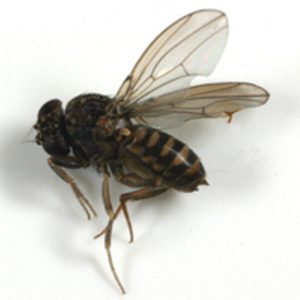
The housefly, Musca domestica , is found worldwide and lives in close proximity to humans. Because houseflies can carry many diseases of humans and domestic animals, it is important to keep their populations low. Understanding their habits and life cycle can help you eliminate the most flies at the lowest cost to you and the environment.
Description
The housefly is a nonbiting fly measuring about 1/4 inch long. Adult houseflies have two wings and four lengthwise black stripes on their backs. The abdomen typically appears checkered.
Houseflies are often confused with flesh flies and stable flies. A flesh fly has only three stripes on its back, and the tip of its abdomen is usually red. The stable fly feeds on blood and its mouthparts protrude from the front of its head.
Life cycle
Houseflies live for up to 3 weeks and are active during the warmer part of the year. An adult female deposits 50 to 100 eggs at a time and about 500 eggs over her lifetime. The eggs are deposited in rotting organic matter. They hatch after about 12 hours and the larvae, or maggots, feed on the rotting organic material. A maggot passes through three larval stages and then forms a pupa, or cocoon. The adult fly emerges from the cocoon. Houseflies typically develop from egg to adult within 10 days.
Control
Three types of control methods are used to suppress houseflies: cultural, biological and chemical. It is best to use all three methods.
Cultural control
Cultural control means changing the environment to prevent houseflies from developing. The best cultural method is to properly dispose of any organic matter, such as vegetable or other food by-products, where houseflies might lay eggs. Place these materials in garbage bags and tie the bags securely. Remove all food residues and clean your garbage cans weekly.
Another cultural method is to keep houseflies out of homes and businesses by
- keeping windows screened and doors closed,
- placing exhaust (blower) systems above doors, and
- installing doors that open and close mechanically.
Sticky traps and ultraviolet light traps placed around a home or business also can reduce housefly populations. Hang resin strips (flypaper) in infested areas where there is little or no air movement. A rule of thumb is to place one 10-inch strip per 1,000 cubic feet of space. Install the fly strips within 6 feet of the floor because most fly activity is near the ground. The strips are effective for up to about 3 months or until completely covered.
Install light traps where they cannot be seen by flies outdoors to avoid attracting more insects to the building. To make the traps more noticeable to the flies in a room, place them at least 15 feet away from doors and other entryways and in darker areas away from bright lights and sunlight. Place the traps at least 5 feet away from food preparation areas to minimize the risk of food contamination. It is important to maintain the traps. Replace the bulbs each spring just before the peak season of fly activity because older bulbs lose their attractiveness to insects. Also clean them out regularly because dead flies serve as food for other insects.
Biological control
Parasitic wasps and fire ants suppress housefly populations naturally. If you want to use this form of natural pest control, you can order fly pupae from insectaries in Texas or across the United States.
The pupae, which are already infected with the parasites, can be spread around homes or near where houseflies are developing. Place the pupae in areas out of direct sunlight where they will not be stepped on.
Parasitic wasps do not harm people or animals. They seek out and kill immature houseflies. However, parasitic wasps take time to work, and they alone will not eliminate a housefly population. Use this method in combination with other methods.
Chemical control
When necessary, insecticides can help suppress housefly populations. Fly baits, such as QuickBayt® and Golden Malrin®, are usually sugar-based and contain a compound that attracts the adult flies. Flies that feed on these baits are killed by the insecticide they digest.
Many spray pyrethroid-based insecticides can suppress houseflies in and around homes. These products can be purchased at grocery and hardware stores. Be sure to read and follow the instructions on all insecticide labels.
The information given herein is for educational purposes only. Reference to commercial products or trade names is made with the understanding that no discrimination is intended and no endorsement by the Texas A&M AgriLife Extension Service is implied.
